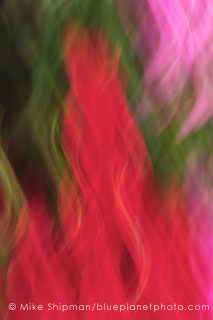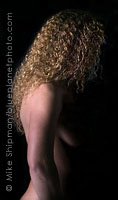Creativity

So, where does it come from? Is it inherent or learned? And, if it is learned, can it be taught or is it merely discovered and nurtured through guidance? Well, if that's the case then I tend to lean toward creativity being inherent, only most of us tend not to notice we have it. Creative inspiration comes from many sources though primarily from our own experiences, past, present and future (future experience being what we hope/dream/plan. How we perceive our future impacts how we feel and what we do in the present). We're certainly influenced by what we see others do, adapting someone's perception to our own, sometimes outright copying or "appropriating" (what a nice word that also means "plagiarize"). Mostly, creativity seems to be an internal force, maybe a 7th sense. It's definitely a means of communication different from sound, sight, taste or touch, yet incorporating elements of each as well as something more.

When I first started getting serious about photography I think my mode of thinking was like most everyone else in that same situation. I read several articles and books that differed in their response to the question "where do I get my inspiration from?". Many of them recommended looking at what others were doing and either to emulate them or take their vision and modify it. Very few said "do what comes natural" which is what I really wanted to do. After more thought I decided that doing what came natural to me would be both more personally satisfying and open up more avenues to be truly creative rather than just mimicking what was already out there. I have to say that I'm not there yet, it's possibly a longer road than emulation, and that along the way I've probably copied several artist's works without realizing it.
I used to not read art books or look at what others were doing, just so I wouldn't be unduly influenced. By not looking at other stuff, I could be assured that what I was coming up with was not based on something I'd seen, but on my own creativity, my own vision. Eventually, though, I started looking at magazines, books, the internet, not so much to get ideas but now to compare what I was doing with what was out there. I saw, and still see, quite a bit of work that blows me away.
 Dedication has a lot to do with creativity. Time and effort spent experimenting, technical knowledge, life experiences, simple contemplation, all come together like a recipe made from scratch, sometimes appearing easily, other times being forced out or dragged out then hammered into shape.
Dedication has a lot to do with creativity. Time and effort spent experimenting, technical knowledge, life experiences, simple contemplation, all come together like a recipe made from scratch, sometimes appearing easily, other times being forced out or dragged out then hammered into shape. Creativity has everything to do with how we see, perceive, and experience the world around us. Our vision, a biological process involving photons of light energy refracted and focused onto nerve endings then decoded by our brain, is selective. Millennia of evolutionary change has not completely dulled our visual perceptions, but our lifestyle has. Our brain is more or less hardwired to respond to situations that might either pose a danger or benefit to ourselves.
Back in the day, our simple lives were centered around eating or being eaten. We tended to be more aware of our surroundings, paying attention to subtle clues and cues, always vigilant for predators, prey, or food. Our current lifestyle (at least in developed countries) does not necessarily require us to take advantage of any situation. We are not always looking for food or running away from being food. We have jobs, supermarkets, traffic lights, fences, policemen and military, government, tailors and seamstresses, butchers and bakers, auto repairmen, plumbers, pilots, and preachers all taking care of us, helping us
 cope, doing some of the work needed for our individual selves to survive. That leaves us to daydream, worry about relatively insignificant things, listen to music, get into a routine. That routine, traveling the same path day after day, passing the same buildings, driving the same streets, encountering the same people, becomes familiar. Familiarity leads to complacency. We stop noticing what's going on.
cope, doing some of the work needed for our individual selves to survive. That leaves us to daydream, worry about relatively insignificant things, listen to music, get into a routine. That routine, traveling the same path day after day, passing the same buildings, driving the same streets, encountering the same people, becomes familiar. Familiarity leads to complacency. We stop noticing what's going on.In the present day, we tend to only notice (or be aware of) those things that are a holdover from the tundra, those events that effect us directly in terms of food or being food (or personal danger). Lights and sirens, smoke, loud bangs or shouts, bright colors, someone standing too close or staring, certain smells, certain types of touching, certain movements of things, like trains, cars, airplanes. The rest of the environment is ignored. Common things, cars, people, buildings, weather, all meld into the background noise of our routine. Our senses are dulled, our awareness is stifled. Consider the nightly news and other television entertainment. Shocking stories, outrageous acts get our attention. The Discovery Channel used to be about education and learning, now it's about celebrity and extremism.
Creativity can be stifled by too much information, too much going on. We are inundated by new technology, iPods, Tivo, cell phones, email, the internet, natural disasters, the economy, digital photography, Photoshop, instant gratification, short attention spans, terrorism, urban growth, the list goes on. Sean Kernan, in the January/February 2006 issue (Vol 47 No 8) of Communication Arts says
"Right now we are all like seasick passnegers on an ocean liner who just want the damned boat to stop rocking. There is too much that is new in our lives, and little of it is good.
Stiil, instinctively, we know that the only way out is forward. And this stasis will end thanks to something new that stands out against the field of the familiar...the way to move forward is to be new ourselves, to free up our seeing and thinking so we will not miss the turn on a new road forward."
Creativity can be learned, I believe. It's the individual that needs to make the
 first move, to regain awareness of yourself as well as the environment around you, and how you fit into, relate to, and move around in it. Doing that requires some amount of work and effort. Look at the bottom of this post for a short list of good books. Take a workshop not on technical aspects of photography or art, but purely on creativity. Take a workshop for an artform you don't currently do, like acting or painting or pottery. Expand your horizons. Read, fiction, non-fiction, trade magazines, popular magazines, comic books. Go to museums. Visit your state capitol and other historic buildings and actually look at the architecture. Listen to your family. Go to the mall and just sit and watch people interact with one another, watch their behaviors and gestures. Go to the woods, desert, ocean and just sit quietly alone, listening, opening up your senses to your surroundings. Imagine.
first move, to regain awareness of yourself as well as the environment around you, and how you fit into, relate to, and move around in it. Doing that requires some amount of work and effort. Look at the bottom of this post for a short list of good books. Take a workshop not on technical aspects of photography or art, but purely on creativity. Take a workshop for an artform you don't currently do, like acting or painting or pottery. Expand your horizons. Read, fiction, non-fiction, trade magazines, popular magazines, comic books. Go to museums. Visit your state capitol and other historic buildings and actually look at the architecture. Listen to your family. Go to the mall and just sit and watch people interact with one another, watch their behaviors and gestures. Go to the woods, desert, ocean and just sit quietly alone, listening, opening up your senses to your surroundings. Imagine.Photography (art in general) can be a limitation to awareness. When you've been looking at the world in snapshots ("That would make a great picture", "That's the painting I'll do next") we, like the camera, eliminate what is going on around us. Sometimes it's helpful to put down the artist tools, put away the artist. And just be.
References:
Phillipe L. Gross and S.I. Shapiro. 2001. The Tao of Photography: Seeing Beyond Seeing. Ten Speed Press
David Bayles and Ted Orland. 1993. Art & Fear: Observations on the perils (and rewards) of artmaking. Image Continuum Press
Andreas Feininger. 1973. Principles of Composition. Amphoto Press
Ansel Adams. 1983. Examples: The making of 40 photographs. Little, Brown & Company




0 Comments:
Post a Comment
<< Home